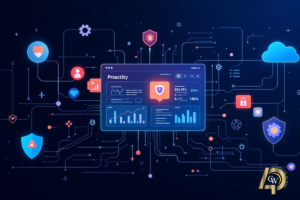Exploring the Depths of System Vulnerabilities: Risks, Responses, and Resilience Strategies
New Research Shows IoT and OT Innovation is Critical to Business but Comes with Significant Risk
The Internet of Things (IoT) and operational technology (OT) are becoming increasingly critical to the success of many businesses. IoT refers to the interconnected network of physical devices, vehicles, buildings, and other objects that are embedded with sensors, software, and network connectivity, allowing them to collect and exchange data. OT includes the devices, systems, and networks that are used to control and monitor industrial processes and critical infrastructure.
New research suggests that IoT and OT innovation is critical to business as it can help companies gain new insights, improve efficiency, and drive new revenue streams. However, the same research also shows that IoT and OT also come with significant risks.
One of the main risks associated with IoT and OT is the potential for cyberattacks. As these systems are connected to the internet, they are vulnerable to hacking and other forms of cybercrime. This can lead to data breaches, loss of control over critical systems, and even physical damage to equipment.
Another risk is the potential for human error. As IoT and OT systems become more complex, there is a greater chance that something could go wrong, either through a mistake or lack of understanding of how the system works.
Finally, there is also a risk of regulatory compliance. IoT and OT systems can generate large amounts of data, and companies need to ensure that they are in compliance with regulations related to data privacy and security.
Overall, businesses must weigh the potential benefits of IoT and OT innovation against the risks, and take steps to mitigate those risks through the implementation of proper security measures and governance.
This blog explores the security risks inherent with IoT/OT and concludes adoption is critical even with the security challenges. In addition, it provides a link to a collaborative report from Microsoft and the Ponemon Institute highligting data on the state of IoT and OT security from a customer’s perspective.
4 Types of Vulnerability
There are four main types of vulnerability that businesses need to consider when it comes to IoT and OT systems: technical vulnerabilities, human vulnerabilities, operational vulnerabilities, and regulatory vulnerabilities.
Technical Vulnerabilities
Technical vulnerabilities refer to weaknesses or flaws in the design or implementation of IoT and OT systems. These can be caused by software bugs, misconfiguration, or inadequate security measures.
To mitigate technical vulnerabilities, businesses should regularly update and patch their systems, conduct thorough security testing, and implement strong authentication measures such as multi-factor authentication.
Human Vulnerabilities
As mentioned earlier, human error can also pose a significant risk to IoT and OT systems. This can include unintentional actions such as misconfigurations or accidental data breaches, as well as intentional actions by employees or insiders with malicious intent.
To address human vulnerabilities, businesses should invest in employee training and awareness programs to educate their workforce on the proper use and security protocols for IoT and OT systems. Additionally, implementing strict access controls and monitoring user activity can also help mitigate the risk of insider threats.
Operational Vulnerabilities
Operational vulnerabilities refer to weaknesses in the processes and procedures surrounding IoT and OT systems. This can include inadequate backup and disaster recovery plans, poor system monitoring, or a lack of incident response protocols.
To address operational vulnerabilities, businesses should establish clear policies and procedures for managing their IoT and OT systems, conduct regular audits and assessments, and have a robust incident response plan in place.
Regulatory Vulnerabilities
Lastly, regulatory vulnerabilities refer to the risk of non-compliance with laws and regulations related to data privacy and security. As mentioned earlier, IoT and OT systems can generate large amounts of data, making compliance a complex task for businesses.
To mitigate regulatory vulnerabilities, companies must ensure that they are following all relevant regulations and implementing appropriate security measures. This may involve working closely with legal and compliance teams to ensure all necessary guidelines are being met.

IT Services – Scaling Your Stuart Business Strategically and Paving the Way for Growth

Small Business IT Support – Why Proactive IT Support is a Game Changer for Stuart’s Small Businesses

IT Support Stuart FL – When Is It Time to Outsource Your IT?

4 Compelling Reasons to Utilize Managed IT Services in Florida for Your Business Growth

40 Years of C&W: Our Story, Our People, Our Future as an Experienced IT Company

IT Helpdesk for Small to Medium Sized Businesses

8 Common IT Problems Solved by Managed IT Services

Benefits of Proactive IT: Boost Your Business Efficiency

Achieving IT Scalability in 2025

Overwhelmed by the Number of IT Vendors? Tech Overload Frustrations

Why Inconsistent IT Support Quality Leads to Major IT Failures

Mastering Remote Workforce Management: Best Strategies & Tools
System Vulnerabilities: Major Causes
While the four types of vulnerabilities discussed above can lead to system vulnerabilities, there are also specific factors that contribute to these weaknesses. Some of the major causes include:
- Lack of security by design: Many IoT and OT systems were not designed with security as a top priority, making them more vulnerable to attacks.
- Inadequate encryption: Without strong encryption methods in place, data transmitted between devices and systems can be easily intercepted and compromised.
- Poorly secured network connections: IoT and OT systems rely on network connections to function, making them susceptible to attacks if the networks are not properly secured.
- Legacy systems: Older IoT and OT systems may not have the latest security measures in place, leaving them vulnerable to newer threats.
- Limited visibility: With the vast amount of data generated by IoT and OT systems, it can be challenging to monitor all activity and detect anomalies or threats.
Protecting Against Vulnerabilities
Despite the risks associated with IoT and OT, businesses cannot afford to ignore their potential benefits. Therefore, it is essential to take proactive measures to protect these systems from vulnerabilities. Some steps that businesses can take include:
- Implementing security by design principles in the development and deployment of IoT and OT systems. This includes considering security at every stage of the process, from design to implementation to maintenance.
- Conducting regular risk assessments and audits to identify potential vulnerabilities and address them proactively.
- Implementing strong data encryption methods to protect data in transit and at rest.
- Implementing proper access controls to limit who can access sensitive data and systems.
- Monitoring network connections and system activity for any anomalies or suspicious behavior.
- Regularly updating and patching all IoT and OT systems to address known vulnerabilities.
- Establishing clear policies and procedures for managing these systems, including incident response plans in case of a security breach.
By taking these proactive measures, businesses can better protect their IoT and OT systems from vulnerabilities and minimize the risk of cyber attacks. As technology continues to evolve, it is crucial for companies to stay vigilant in their security practices and regularly assess and update their systems to keep up with emerging threats.
Empowering Your IT Landscape: Why Choosing C&W Technologies is Your Best Bet for Future-Proof Solutions
In today’s rapidly advancing digital landscape, it is more important than ever for businesses to have reliable and secure IT systems in place. This is especially true for companies that rely heavily on IoT and OT technologies. With the potential risks and vulnerabilities associated with these systems, choosing a trusted technology partner is crucial for ensuring their safe and effective implementation.
By partnering with C&W Technologies, companies can have peace of mind knowing that their IoT and OT systems are in safe hands. Our company stays up-to-date with the latest advancements in technology and security to ensure our clients’ systems remain secure against evolving threats.
Choose C&W Technologies as your trusted technology partner for future-proof solutions today. By choosing C&W Technologies as your trusted technology partner, you’re choosing to protect your business and its valuable assets from potential vulnerabilities. Let C&W Technologies be your best bet for future-proof solutions. Contact us today!
Frequently Asked Questions (FAQs)
Q: What is an operating system?
A: An operating system (OS) is the underlying software that manages and controls a computer’s basic functions, such as memory, hardware, and software interaction. It acts as an intermediary between the user and the computer hardware.
Q: What is a computer system?
A: A computer system refers to the combination of hardware, software, and peripherals that work together to perform various tasks and functions. This includes components such as the central processing unit (CPU), memory, storage devices, input/output devices, and operating system.
Q: How can businesses protect against security vulnerabilities in IoT and OT systems?
A: Businesses can protect against security vulnerabilities by implementing security measures such as encryption, access controls, regular updates and patches, and established policies and procedures for managing these systems. It is also important to conduct risk assessments and stay vigilant for any anomalies or suspicious activity. Partnering with a trusted technology partner like C&W Technologies can also help ensure the safe and secure implementation of these systems.
Q: What is computer security?
A: Computer security refers to the protection of sensitive information and systems from unauthorized access, use, disclosure, disruption, modification, or destruction. It involves implementing various measures such as firewalls, antivirus software, and encryption to prevent cyber attacks and protect against potential vulnerabilities.
Q: What are system security procedures?
A: System security procedures refer to established protocols and measures for protecting a computer or network from cyber threats. These can include regular updates and patches, implementing access controls, conducting risk assessments, and monitoring system activity for any anomalies or suspicious behavior.
Q: What are network vulnerabilities?
A: Network vulnerabilities refer to weaknesses or flaws in a computer network that can be exploited by cyber attackers to gain unauthorized access, steal sensitive information, or disrupt normal operations. These vulnerabilities can arise from outdated software, weak passwords, unsecured connections, and other factors.
Q: How does malicious code impact businesses?
A: For businesses, malicious code can lead to significant disruptions, including loss of data, theft of sensitive information, financial losses, and damage to reputation. Businesses must implement robust cybersecurity measures, including employee training, to mitigate the risks posed by malicious code.
Q: Can operating system vulnerabilities lead to data breaches?
A: Yes, attackers can exploit operating system vulnerabilities to gain unauthorized access to systems and data, potentially leading to data breaches. This is why maintaining a secure and updated operating system is crucial for personal and organizational security.
Q: What tools are used in vulnerability management?
A: Vulnerability management tools vary widely, from simple vulnerability scanners to comprehensive management platforms. These tools help in scanning, identification, analysis, prioritization, and reporting of vulnerabilities.
Q: How do I choose the right antivirus software?
A: When choosing antivirus software, consider factors such as detection rates, system impact, ease of use, feature set, compatibility with your operating system, and cost. Reading independent lab tests and reviews can help you compare and decide on the best antivirus solution for your needs.
Q: What is a security vulnerability?
A: A security vulnerability refers to a flaw or weakness in a system’s design, implementation, operation, or management that could be exploited to violate the system’s security policy. Vulnerabilities can exist in software, hardware, network protocols, or organizational processes.
Q: What is a data breach?
A: A data breach is an unauthorized access or release of sensitive or confidential information. This can happen due to cyber attacks, human error, or system vulnerabilities and can result in the exposure of personal information, financial data, trade secrets, and more. Data breaches can have severe consequences for businesses and individuals alike.
